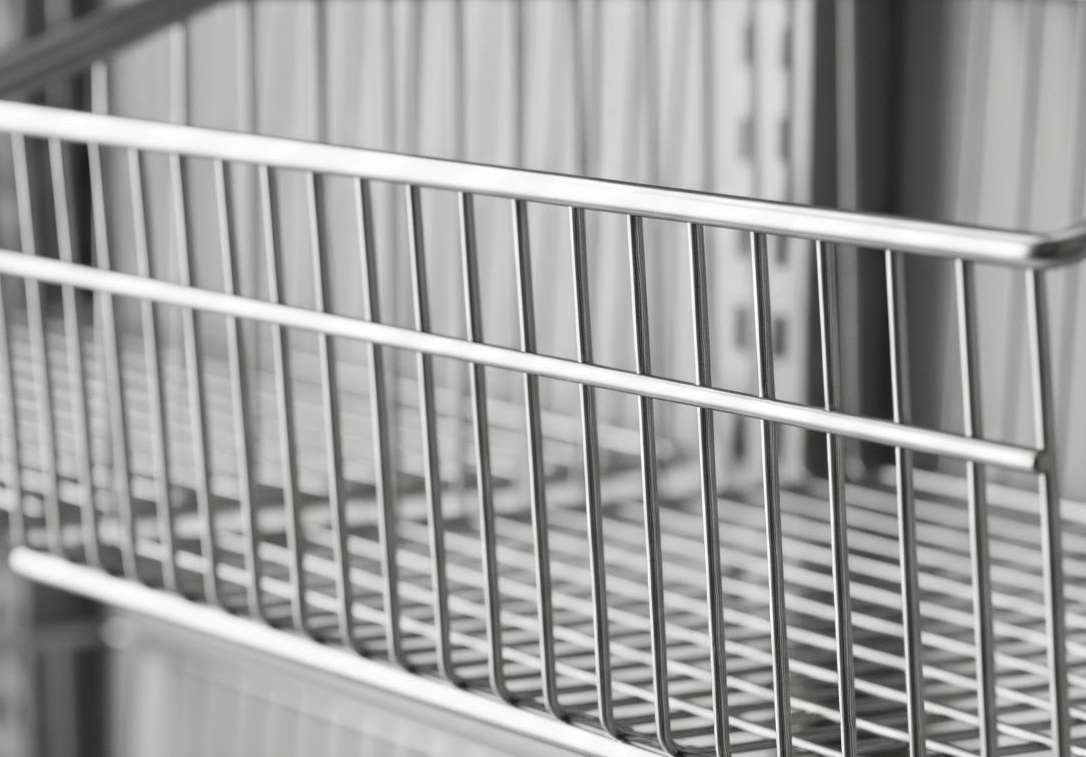Every healthcare team wants an efficient, clean, and organized supply system. There’s one small choice that can make a surprisingly big impact: wire supply baskets versus plastic bins.
It’s easy to assume plastic bins are the cheaper option: they can look tidy, come in bright colours, and seem simple enough. But when you dig into the day-to-day use, the true cost of plastic bins starts to add up.
Plastic bins trap dust and debris in corners and seams. They require frequent hand-cleaning, one at a time, to avoid cross-contamination. Depending on their location this could be as frequently as weekly! It’s a job that easily adds hours to a technician’s week, and with labour costs being what they are, those hours quickly translate to real dollars. Not to mention operational slow-downs: when bins crack, warp, or lose labels, items get misplaced or mis-pulled, setting off a ripple effect through the supply chain. Shelf bins also have lots of tight spots that are difficult to clean effectively thanks to their many corners, lips and divider slots.
Fine mesh, wire supply baskets, on the other hand, are built for real-world healthcare use. They clean faster and more completely: no corners to trap bacteria, no stuck-on tape, no tedious wipe-downs. Their open design improves airflow and visibility, meaning stock checks and restocks happen quickly and accurately. Over the lifespan of a unit or department, the time saved in cleaning and the reduction in supply errors often more than offsets the initial investment.
To provide a clearer picture of the cost differences and true value between supply baskets and plastic bins, here’s a detailed comparison highlighting unit prices, storage efficiency, cleaning labor impact, and estimated ROI periods.
| Feature / Cost Element | Epoxy Finish Supply Basket Unit (36”) | Chrome Finish Supply Basket Unit (36”) | Wire Cart with Plastic Shelf Bins (48”) |
| Unit Price (Estimates) | $3,000 | $2,500 | $1,200 |
| Finish Type | Epoxy coating (softens wire ends) | Nickel chrome finish | Plastic bins on wire frame |
| Storage Efficiency | Baseline (high efficiency) | Baseline (high efficiency) | 30-40% less efficient than baskets |
| Size Comparison | 36” wide | 36” wide | 48” wide |
| Labor Cost Assumption (per hour) | $40/hr | $40/hr | $40/hr |
| Estimated ROI on Cleaning (Monthly Cleaning Protocol) | ~1 year 8 months | ~1 year 4 months | Longer (due to frequent, manual cleaning) |
| Estimated ROI on Cleaning (Weekly Cleaning Protocol) | ~5 months | ~4 months | Longer (more cleaning labor hours) |
While the upfront cost of plastic shelf bin wire carts is significantly lower, by roughly $1,300 to $1,800 compared to supply baskets, the hidden costs quickly shift the balance. Plastic bins demand frequent, labor-intensive cleaning to meet hospital hygiene protocols. Using $40/hour labor costs, monthly cleaning cycles mean the higher-priced basket unit pays for itself in about 16-20 months. Weekly cleaning boosts ROI to just 3-5 months.
This table only captures cleaning labor costs. Other factors include increased infection risk due to missed cleaning, replacement costs of cracked or repurposed bins, and inefficient storage requiring more space for the same supplies. Importantly, the opportunity cost of staff time spent on cleaning instead of patient care is difficult to quantify but crucial in today’s labor-stressed healthcare environment.
The lesson? What looks cheaper on paper isn’t always the least expensive in practice. The “true cost” lies not in purchase price, but in the hours lost, processes slowed, and hygiene risks accepted.
At Forsyth Healthcare, we’re laser-focused on helping our partners see these kinds of trade-offs clearly. Because behind every recommendation we make is the same goal we hold for every project: relentlessly delivering easy: saving time, cutting friction, and finding ways to make healthcare run smoother for everyone involved.


